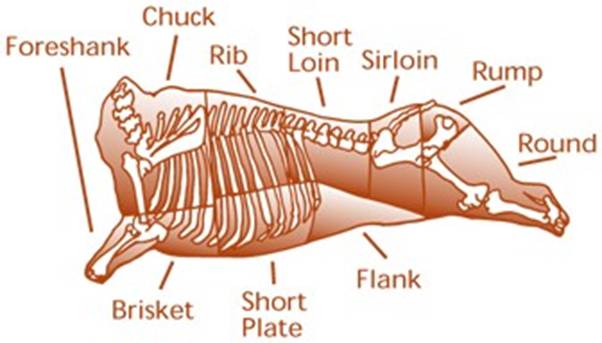These are the most tender cuts.
The asterisks show the most popular cuts.
For tender cuts, use dry cooking techniques such as: broiling, grilling, sautéing, roasting.
- Loin
The loin is meant for the ultimate steak lover, and has the most tender and expensive cuts. we recommend using dry cooking methods for these, including broiling, grilling and roasting.
- shell sirloin steak (bone-in)*
- boneless sirloin steak
- porterhouse steak *
- t-bone steak
- NY strip steak (boneless) *
- tenderloin steak (filet mignon)
- whole peeled tenderloin
- Rib
The rib section offers steaks and roasts that are tender and flavorful. These cuts are better prepared with dry cooking methods, and should not be marinated.
- rib eye steak (boneless)*
- rib eye steak (bone in)
- rib eye roast (boneless)
- rib eye roast (bone in)
- beef back ribs
These are the less tender cuts
but they still will be delicious if prepared right. The less tender portions of the cow can be tougher, so one rule of thumb to keep in mind is when cooking less tender pieces of beef, use long, slow, moist heat cooking methods: braising, stewing, boiling
- Chuck
The chuck has some of the most economical, yet flavorful cuts. Since they can be tough, chuck cuts are usually best prepared with moist cooking methods, but there are exceptions. My local grocery store Peppers sells chuck cuts that are surprisingly tender and do quite well pan-fried or roasted.
- chuck steak (boneless)
- chuck steak (bone-in)
- chuck roast (boneless)*
- chuck roast (bone-in)
- chuck eye steak
- boneless chuck top blade steak
- boneless shoulder steak
- boneless shoulder roast
- boneless shoulder london broil*
- beef cubed steak
- Brisket
The brisket requires long moist cooking, but the outcome is delicious.
- whole packer brisket
- rimmed brisket
- corned beef brisket
- brisket top
- brisket flat
- Shank
The shank cuts are best prepared with moist cooking methods, like braising or in stews and stock.
- beef shank center cut
- beef shank end cut
- beef stew meat
- Plate
The plate cuts can be medium in their toughness and are best braised and even boiled.
- boneless stew beef
- beef short ribs (boneless or bone in)
- Flank
The flank. Its most popular cut, the flank steak, can be very delicious grilled, as long as the meat is marinated first.
- fflank steak*
- Round
The round provides a variety of cuts that are a little tougher and leaner. Some, like the top round and the top round London broil, are more tender and can be prepared with dry methods as well as moist.
- bottom round steak
- bottom round roast*
- eye round steak
- eye round roast*
- eye round sandwich steak
- top round steak
- top round roast*
- top round bracciole
- top round sandwich steak
- top round London broil*
- sirloin tip steak
- sirloin tip roast*
- sirloin tip steak silverside
- silver tip silverside roast
- sirloin tip sandwich steak
- beef cubed steak
- Rump
The rump of the cow has meat that can be tough to tenderize. Moist cooking methods are recommended.
- rump roast
- beef oxtails
cutting against the grain
To serve the tenderest possible meat, you should cut the meat 'against the grain' whenever possible. When you look at a piece of meat, you can see the direction of the muscle fibers.
Each muscle fiber is encased in a collagen sheet that holds it together, muscle fiber bundles are encased in bigger sheets, each muscle is encased in an even thicker sheet, and the entire limb is cased in the thickest sheet.
Collagen is a tough non-elastic fiber. If you leave long pieces of it, the meat will be tough and chewy. If on the other hand, you cut these fibers in short little pieces—which happens by 'cutting against the grain'—then they won't be nearly as bothersome.
- When you have cooked a roast,
- look at the direction of the muscle fibers and cut perpendicular to that direction to get tender slices. That will often not be a different direction than the largest flat surface of the roast.
- If you cut along the direction of the muscle fibers, you'll have long stretches of collagen, and the slice will be a lot chewier.
- Some cuts like brisket have thick muscle fibers running in different directions from a central tendon sheet. To cut against the grain, you have to slice those 2 parts separately in different directions.
- Some cuts like steaks and London Broil should have been cut against the grain by the butcher. The only way to still cut against the grain there is by slicing the steak into thinner steaks.
- Moist heat dissolves the collagen, which is why the toughest cuts are always boiled or braised for extended times. If you boil a muscle long enough, the strands will separate into 'pulled meat.'
Not included in the above:
Low-temperature cooking—as low as 132 ºF—is my preferred method for thicker cuts, in combination with searing before and also after the cooking for roasts and steaks. The initial searing seals and sterilizes the meat surface and adds extra flavor. The finishing searing adds more color and flavor.
The prolonged low-temperature cooking ensures that the meat is cooked and pasteurized evenly throughout the cut but avoids the loss of color and moisture that is seen with high-temperature cooking. In other words: the meat remains pink and juicy as long as the temperature is kept low enough.
recipe page links
 Pic1:
smaller picture, easier to read
Pic1:
smaller picture, easier to read Pic1:
smaller picture, easier to read
Pic1:
smaller picture, easier to read